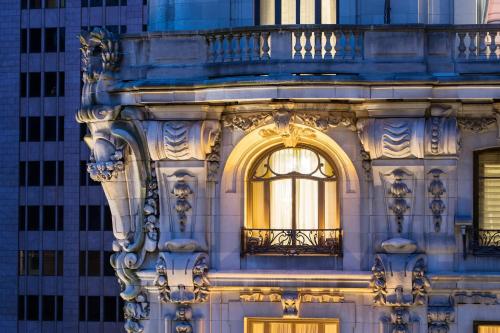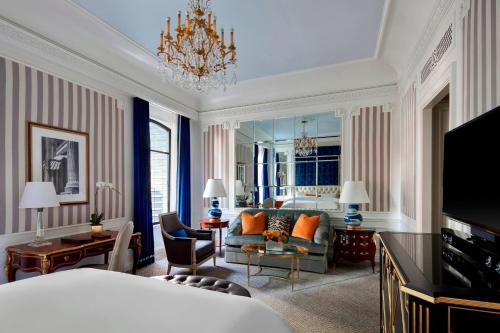









The St. Regis New York : Hôtel emblématique et bar légendaire
Inauguré en 1904 par John Jacob Astor IV, le St. Regis New York est un hôtel emblématique situé au 2 E 55th St, dans le quartier de Midtown Manhattan. Construit dans un style Beaux-Arts français, il incarne le luxe et l’élégance intemporelle de la ville qui ne dort jamais. Depuis ses débuts, cet établissement a accueilli des figures célèbres telles que Salvador Dali, Marlene Dietrich ou encore Alfred Hitchcock, renforçant sa réputation de lieu prestigieux au cœur de New York.
Le St. Regis se distingue par ses services haut de gamme, notamment son célèbre bar King Cole, où l’on peut déguster le fameux Bloody Mary, inventé en 1934 par un barman français. L’hôtel propose également un restaurant raffiné et des suites somptueuses, parfaites pour une expérience de séjour inoubliable. Son ambiance raffinée, mêlant luxe classique et touches modernes, en fait un lieu incontournable pour les amateurs de glamour et d’histoire, à deux pas de l’effervescence de la Fifth Avenue.
L’atmosphère du St. Regis New York évoque le faste du passé, avec un décor élégant comprenant des chandeliers, des œuvres d’art et un mobilier en velours bleu ou en soie. La décoration, à la fois sophistiquée et chaleureuse, rappelle l’époque où Gossip Girl faisait vibrer Manhattan. Ce lieu respire le charme d’antan, tout en offrant un confort contemporain, dans un cadre qui semble tout droit sorti d’un film ou d’un roman glamour. Un véritable symbole de l’élégance new-yorkaise, où chaque détail raconte une histoire de luxe et de prestige.
Vos retours sont importants pour nous. Si vous avez remarqué une erreur concernant ce lieu, merci de nous en informer pour que nous puissions la corriger.
Nous récupérons automatiquement les informations disponibles sur votre lieu. Si jamais celles-ci ne sont pas correctes, connectez-vous gratuitement sur notre tableau de bord pour les modifier et bonus, accédez à vos statistiques détaillées.
 Shake Shack
630 Lexington Ave New York, NY 10022 USA
Ajouté par247 utilisateurs
Shake Shack
630 Lexington Ave New York, NY 10022 USA
Ajouté par247 utilisateurs

"Even the most unaffected New Yorkers can’t help but feel a tinge of nostalgia when passing through the gilded revolving doors of the St. Regis, promptly greeted by a gentleman with white gloves and a smile. The sense of the city’s golden era lingers in that lobby, where shining chandeliers warm the pale walls to create a necessary calming counter to the crush of cabs and suits in Midtown Manhattan. It’s precisely the atmosphere John Jacob Astor IV sought to capture when he opened this 18-story, Beaux-Arts landmark at the turn of last century. Today, there’s more Michael Kors than mink in the King Cole Bar, though the order hasn’t changed: Ignore the lengthy cocktail list and go for a note-perfect dry Martini or a Bloody Mary, the house speciality, and fall into conversation with the bankers in from Boston sitting at the bar. For those who do stay on for another martini (or three), it’s nice to know that your suite is just an elevator ride away. It may be done up in lipstick-ruby wallpaper or blue velvet curtains and striped white walls, with classic pieces such as silk-stitched love seats and oil paintings to resemble that glamorous pied à terre everyone fantasizes about. This is a New York institution that channels the city’s glamorous past like no other, steps from the Fifth Avenue buzz."
@chaunch26
"That killer King Coke Bar inside is badass"
@jeffreydungan
"Où était censée se passer l’enterrement de vie de jeune fille de Blair dans la suite Tiffanys."
@
"Le St. Regis fut construit en 1904 dans un style Beaux-Arts français par John Jacob Astor IV, l'un des hommes d'affaires les plus riches de l'époque. Le promoteur immobilier trouva la mort huit ans plus tard, lors du naufrage du Titanic. Même si vous ne résidez pas au St. Regis, n'hésitez pas à vous offrir un verre au King Cole Bar. En 1934, un an après la levée de la prohibition, un barman français y inventa un cocktail intitulé «Red Snapper» et aujourd'hui connu dans le monde entier sous le nom de «Bloody Mary»."
@
"Le St. Regis fut construit en 1904 dans un style Beaux-Arts français par John Jacob Astor IV, l'un des hommes d'affaires les plus riches de l'époque. Dépassant les 80 mètres, il fut l'hôtel le plus haut de NY à son ouverture. Le promoteur immobilier trouva la mort huit ans plus tard, lors du naufrage du Titanic. Même si vous ne résidez pas au St. Regis, n'hésitez pas à vous offrir un verre au King Cole Bar. En 1934, un an après la levée de la prohibition, un barman français y inventa un cocktail intitulé «Red Snapper» et aujourd'hui connu dans le monde entier sous le nom de «Bloody Mary»."
@
"Bar king Cole uppfann bloody Mary "
@maria.masgard
"GLH 5* | 229 rooms from €570pn HISTORIC, GLAMOROUS John Jacob Astor, who perished on the RMS Titanic, opened this neoclassical beauty in 1904. Soon the St. Regis was among the most stylish addresses in town - Salvador Dali (who kept a room for ten years), Marlene Dietrich and Alfred Hitchcock all stayed here, and this original went on to inspire Starwood's premium line of St. Regis Hotels & Resorts. After a thorough renovation, this legendary and timelessly elegant five-star hotel is flying high again, with white-gloved butlers. Ordering a Bloody Mary in the mahogany-heavy King Cole Bar is a must - the spicy tomato classic was concocted by a bartender here in 1934."
@nchavotier
"Go to room 1610 where dali lived. Order a bloody mary (1st was made here)"
@
"Passes out free veuve @ 6pm everyday "
@
"Pastry Chef Patrick.Martinez@marriott.com"
@
"Vaisseau amiral - ancienne propriété de la famille Astor - King Cole bar"
@
"Où était censée se passer l’enterrement de vie de jeune fille de Blair dans la suite Tiffanys."
@
"http://www.artnet.com/artists/maxfield-parrish/"
@
"Le Diable s'habille en Prada / Le Parrain / Radio Days"
@